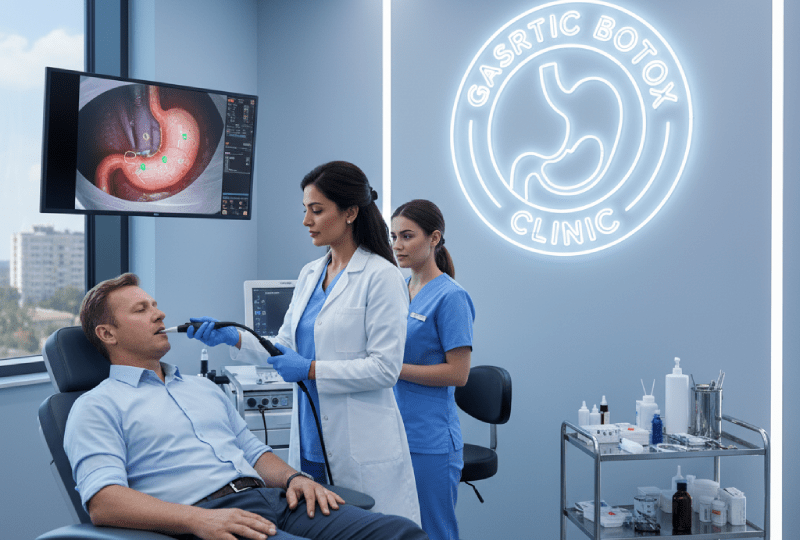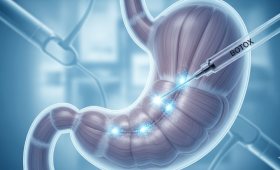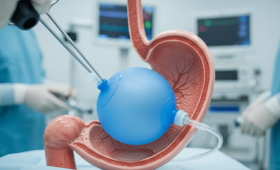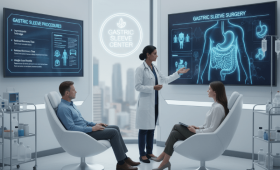How Is Gastric Botox A Procedure?
Gastric Botox is a procedure where botulinum toxin is injected into specific points of the stomach wall using an endoscopic method to temporarily slow down the movement of the stomach muscles. This process aims to increase the patient’s feeling of fullness and enable them to feel satisfied with smaller portions by prolonging the stomach’s emptying time. The botox application, which takes about 15-20 minutes, does not require surgery and is usually performed painlessly under light sedation. Patients can generally be discharged on the same day and quickly return to their daily lives, which increases the comfort of the treatment.
How Is Gastric Balloon Treatment Placed In The Stomach?
In Gastric Balloon treatment, the balloon is placed in the stomach either as a swallowable capsule or using an endoscopic method. In the endoscopic method, the deflated balloon is passed through the patient’s mouth into the stomach under light sedation, and then inflated with sterile liquid or air to take up volume. Capsule balloons are swallowed with water and inflated under radiological guidance once they reach the stomach. The purpose of placing the balloon is to reduce the volume of the stomach, enabling the patient to feel satisfied more quickly and stay full for a longer time. The procedure duration and need for sedation may differ depending on the type of balloon.
How Long Does The Gastric Botox Procedure Take And Is Anesthesia Required?
The Gastric Botox procedure is a very quick application, generally completed in 15 to 20 minutes. Light sedation is administered intravenously during the procedure to ensure the patient does not feel any discomfort. This sedation allows the patient to relax and pass the procedure painlessly without losing consciousness. The application is performed in an endoscopy unit, and the patient can be discharged on the same day after a brief resting period. Because it is a fast and comfortable process, it is frequently preferred by international patients.
How Is The Removal Of The Gastric Balloon Performed?
When the Gastric Balloon’s time inside the stomach is up, the removal procedure is carried out according to the type of balloon. Traditional balloons are deflated with the help of endoscopy, similar to the placement process, and then removed through the mouth. This procedure is also performed under light sedation and takes approximately 20 minutes. Swallowable balloons are usually expelled naturally through the digestive system and do not require a removal procedure. In both cases, the patient’s comfort and safety are the highest priority.
What Are The Side Effects Of Gastric Botox And Is It Risky?
Reported serious side effects of Gastric Botox are extremely rare, and the procedure is generally considered safe. Rare side effects may include mild nausea, bloating, or indigestion after the procedure, but these are usually short-lived. Since the effect of botox is limited only to the stomach muscles, side effects such as muscle paralysis in other parts of the body are not expected. It is vital that the treatment is performed by an experienced specialist and under appropriate conditions to minimize the risk of the treatment.
What Are The Differences Between Gastric Balloon Types?
The fundamental differences between Gastric Balloon types are the duration they remain in the stomach and the method of placement/removal. Traditional endoscopic balloons (such as Orbera) can remain for 6 or 12 months and require endoscopy for removal. Swallowable balloons (such as Elipse) are swallowed without the need for endoscopy and anesthesia, deflate spontaneously after about 4 months, and are expelled through the digestive system. The material and volume of the balloon can also vary between types, which is a factor affecting the patient’s tolerance.
What Are The Advantages Of The Swallowable Gastric Balloon?
The biggest advantages of the Swallowable Gastric Balloon are that it does not require endoscopy, anesthesia, or surgery. This is a comfortable and safe option for patients who have reservations about sedation or surgical risks. The fact that the balloon deflates spontaneously and is expelled naturally when its time inside the stomach is up eliminates the need for a second removal procedure. This convenience increases the interest of international patients with busy travel schedules in the treatment.
What Happens On The First Day After Gastric Balloon Placement?
On the first day after Gastric Balloon placement, nausea, cramps, and discomfort symptoms are generally experienced as the stomach naturally tries to adapt to the balloon. These symptoms are a natural result of the stomach adjusting to the balloon and are controlled with medications prescribed by the doctor (anti-nausea drugs, painkillers). Patients are advised to spend this first 24 hours resting, taking plenty of fluids, and lying down. Close follow-up in the hospital or hotel is of great importance during this critical period.
Why Does The Endoscopic Gastric Balloon Remain In The Stomach For A Longer Time?
Endoscopic Gastric Balloons are generally designed to remain in the stomach for 6 to 12 months because this period is considered sufficient for the patient to permanently adopt new eating habits. These balloons, which can stay in the stomach for a longer time, are suitable for patients aiming for higher excess weight loss. However, the removal procedure for balloons that remain in the stomach for a long time requires endoscopy and sedation.
Is The Process Of Expelling The Swallowable Balloon From The Stomach Painful?
The process of expelling the Swallowable Balloon from the stomach, which occurs through the digestive system after the balloon deflates spontaneously, is generally painless and can be so natural that the patient may not notice it. The outer casing of the balloon dissolves on its own over time, and the sterile liquid inside is expelled. The deflated casing of the balloon is then excreted through normal bowel movements. Very rarely, there may be a temporary feeling of discomfort in the intestinal movements.
What Is The Mechanism Of Action Of Gastric Botox In Overweight Patients?
The mechanism of action of Gastric Botox in overweight patients is based on the fact that it reduces the contraction force of the stomach muscles by inhibiting neurotransmitter release. In this way, the stomach, which normally empties in 1-2 hours, can hold food for about 4-6 hours after the botox application. The food remaining in the stomach constantly sends a signal of fullness to the brain, which leads to the patient feeling less hungry and the desire to snack between meals decreasing.
Is There A Risk Of The Gastric Balloon Bursting?
The risk of the Gastric Balloon bursting is very low thanks to the development of modern medical devices. The balloons are made of durable, medical-grade silicone or a special polymer material designed not to harm the stomach wall. Rarely, balloons that remain in the stomach for a long time may deflate due to material fatigue, but a complete bursting is very rare. In case of deflation, the blue liquid inside changes the color of the urine to warn the patient, and the balloon must be removed endoscopically.
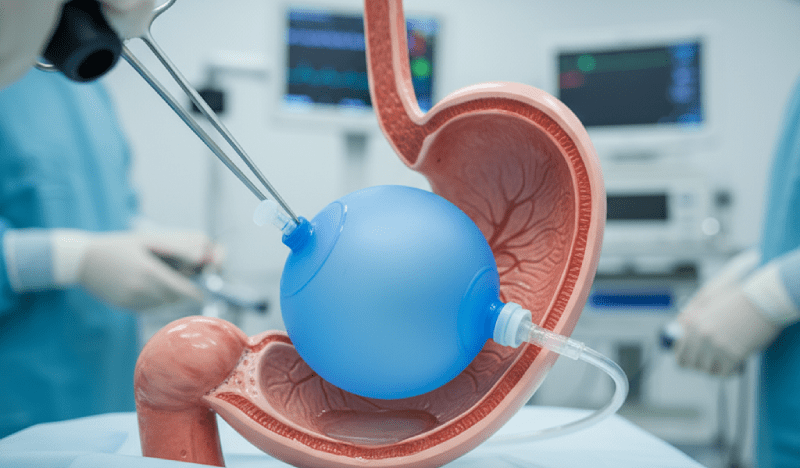
Is The Effect Of The Gastric Botox Application Reversible?
Yes, the effect of the Gastric Botox application is completely reversible. The injected botulinum toxin is naturally metabolized by the body, and the stomach muscles’ contraction function completely returns to its original state within about 6 months. This reversibility is one of the reasons why botox is preferred by patients looking for a less invasive temporary weight control solution compared to surgery.
Is There A Risk Of Gastric Balloon Damaging The Stomach?
The risk of the Gastric Balloon causing permanent damage to the stomach is very low. The balloons are made of soft material and are designed not to harm the stomach wall. However, if the patient has pre-existing stomach conditions such as gastritis or ulcers before the balloon placement, these may be irritated by the presence of the balloon. Therefore, endoscopy is mandatory to check stomach health before the balloon.
Is The Success Rate Of The Swallowable Balloon Different From Traditional Balloons?
The success rate of the Swallowable Balloon is not significantly different from traditional endoscopic balloons. Both types of balloons help the patient restrict their portions. Since the swallowable balloon remains in the stomach for a shorter period (4 months), the total amount of weight lost may be slightly less than with 6-month traditional balloons, but the percentage of weight loss is generally similar.
Is Gastric Botox Suitable For Patients Not Afraid Of Surgery?
Gastric Botox is also suitable for patients who are not afraid of surgery but are looking for a less invasive and temporary solution. This treatment offers the advantages of faster recovery, lower risk, and lower cost compared to surgery. It can also be used as a preliminary trial to test the individual’s weight loss discipline before surgical intervention.
In Which Cases Should Balloon Treatment Be Preferred?
Balloon treatment should be preferred by patients with a higher BMI (between 30-40) and those aiming for greater weight loss. Since the balloon occupies volume in the stomach for a longer time, it provides a stronger feeling of fullness than botox and offers higher weight loss potential. The balloon is also preferred for pre-operative weight loss (bridging therapy) in patients with very high surgical risks.
Can A New Balloon Be Placed After The Balloon Is Removed?
Yes, a new balloon can be placed after a certain waiting period after the balloon is removed, provided the patient is medically suitable and their weight loss goals continue. This is a strategy generally applied to patients who have successfully used one balloon but still need to lose more weight or are having difficulty maintaining the weight lost. The type and duration of the new balloon are determined by the doctor according to the patient’s current condition.
Questions About Suitability, Cost, Recovery, and Long-Term Success
Who Is Suitable For Non-Surgical Weight Loss Treatments?
Non-surgical weight loss treatments are generally ideal for individuals with a Body Mass Index (BMI) between 27 and 40 who have not achieved satisfactory results from diet and exercise programs. These methods are an important alternative for patients who carry surgical risks or prefer not to undergo surgical intervention. The decision regarding suitability for treatment is made after a multidisciplinary team evaluates many factors, such as the patient’s overall health status, co-existing diseases, and psychological preparation level. Gastric botox and balloon applications, in particular, can yield effective results for patients in this group.
How Long Does The Effectiveness Of Non-Surgical Methods Last?
The duration of effectiveness of non-surgical methods varies depending on the applied procedure. The effect of Gastric Botox usually lasts 4 to 6 months, depending on the amount of toxin used and the patient’s metabolism. Gastric Balloons, depending on their type, can remain in the stomach for 4 months up to 12 months. The fundamental success in both treatments depends on the patient maintaining the new eating habits they gain during this period. Returning to old habits after the treatment period ends can lead to weight regain.
Is The Success Of Gastric Balloon Treatment Dependent On BMI?
Yes, the success of Gastric Balloon treatment is largely dependent on the patient’s starting Body Mass Index (BMI) value. In general, patients with a BMI between 30-40 and high motivation achieve the best results. Since the balloon functions as an “aid,” the patient’s strict adherence to the diet and exercise program is the most critical factor in achieving the targeted percentage of weight loss. The presence of the balloon supports the feeling of fullness, facilitating this compliance.
Is The Fee For Dietitian Follow-up During The Treatment Process Included In The Package?
The fee for dietitian follow-up, which is critically important for healthy and permanent weight loss, is generally included in reliable and comprehensive treatment packages. This follow-up can last from 6 months up to 1 year after the balloon placement or botox application. The dietitian closely monitors the patient’s transition to a new eating regimen, especially the liquid and puréed diets in the first few weeks. This continuous support maximizes success and aids in the patient’s physical and psychological adaptation.
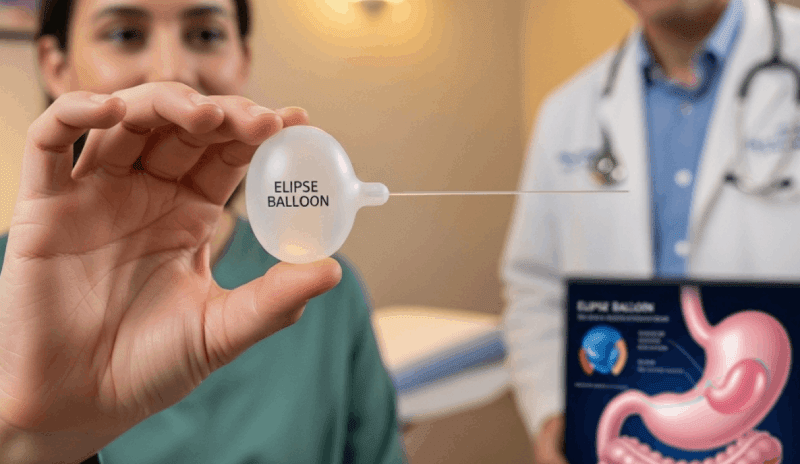
How Long Is The Return-To-Work Time After Gastric Botox?
The Gastric Botox procedure has a very short recovery time because it does not require surgical intervention. Patients can generally return to their daily activities after resting for a few hours on the day of the procedure. Most patients can return to work the next day without any physical restrictions. This fast recovery makes botox treatment a very attractive option, especially for international patients with a busy work schedule.
How Much Weight Loss Should Be Expected With Gastric Balloon Treatment?
The expected weight loss with Gastric Balloon treatment varies depending on the patient’s starting weight, the duration the balloon remains in the stomach, and their compliance with lifestyle changes. On average, patients are expected to lose 10% to 25% of their excess weight. For example, a patient with 50 kg of excess weight aiming to lose 5 to 12.5 kg is a realistic goal. The best results are seen in patients who combine the treatment with intense exercise and a strict diet program.
What Factors Determine The Cost Of Gastric Botox Treatment?
The cost of Gastric Botox treatment is primarily determined by the brand and amount (units) of botulinum toxin used. High-quality, internationally approved toxins are more costly. Additionally, the experience of the specialist performing the procedure, the location of the hospital or clinic where the procedure is performed, and the additional services offered (dietitian follow-up, medications) are other important factors affecting the price. When receiving a price quote, it is vital to examine the details of what is included in the package for transparency.
How Should Nutrition Be After The Gastric Botox Application?
Nutrition after the Gastric Botox application should start with liquid and soft foods for the first few days. Once the botox starts to show its effect, patients need to focus on eating smaller portions and eating slowly. Fatty and difficult-to-digest foods should be avoided as the stomach’s emptying rate slows down. The dietitian will create a personalized long-term nutrition plan, focusing on high-protein and high-fiber foods that do not strain the stomach, which supports permanent weight loss.
Can Gastric Botox Treatment Be Repeated?
Yes, Gastric Botox treatment can generally be repeated after the effect of the first application has worn off (approximately 6 months later). If the patient still has weight loss goals after the toxin’s effect has completely vanished and is medically suitable, a second botox application can be performed. The decision to repeat is made based on the patient’s weight loss success in the first application, compliance with the new lifestyle, and the doctor’s assessment.
When Should The Exercise Routine Be Started After Treatments?
Starting the exercise routine after non-surgical treatments is much faster compared to surgical procedures. After Gastric Botox, light walks can generally be started the next day. After balloon placement, light activities can usually be started within 2-3 days, once the nausea and discomfort have subsided. However, doctor approval should be obtained for heavy exercise and movements that strain the abdominal muscles, and a wait of 1-2 weeks is generally recommended.
How Is Long-Term Success Ensured With Non-Surgical Treatments?
The long-term success of non-surgical treatments is based not only on the procedures applied to the stomach but on the patient’s commitment to permanent lifestyle changes. Small portion eating habits gained during the treatment period, a regular exercise routine, and continuous communication with the dietitian are vital. Maintaining these new habits after the balloon or botox effect wears off is the most fundamental factor preventing weight regain. This is a disciplined journey that starts with a “tool” and lasts a lifetime.
Does Gastric Botox Treatment Offer A Permanent Solution?
Gastric Botox treatment is a temporary solution and is not considered a permanent weight loss method. The effect of botox on the stomach muscles completely disappears within 6 months. This treatment offers a critical “window of opportunity” for the patient to control their appetite and reduce their portions. The permanence of the weight loss achieved from botox depends on the patient internalizing and maintaining the new eating behaviors during this 6-month period.
Which Brands Are Most Preferred For The Gastric Balloon?
The most preferred brands for Gastric Balloons are those that are internationally accepted and have FDA/CE approval. For example, brands like Orbera for endoscopically placed balloons and Elipse for swallowable balloons are frequently preferred. The reasons for preferring these brands are the quality, reliability of their products, and the consistent clinical results achieved. It is important to know about the quality of the balloon brand for the safety and comfort of the treatment.
Is A Special Diet Required Before Gastric Balloon Treatment?
A short-term (3-7 days) liquid or soft food diet is usually recommended before Gastric Balloon treatment. The purpose of this diet is to slightly relieve the stomach and liver and minimize the risk of any complications during the procedure. Liquid food intake continues for the first few days after the balloon is placed to slowly adapt the stomach to the new situation. This pre-preparation is critically important for the success of the treatment.
Is There A Risk Of Stomach Enlargement After Treatments?
The risk of stomach enlargement after non-surgical treatments is present, especially when the treatment duration is over and the patient returns to old unhealthy eating habits. If the patient continues to consume large portions after the effect of Gastric Botox wears off or the Gastric Balloon is removed, the stomach can gradually return to its original volume. The only way to prevent this risk is to adhere to portion control and a healthy eating regimen acquired under dietitian guidance, making it a way of life.
How Is The Age Limit Practice In Non-Surgical Methods?
The age limit practice in non-surgical methods generally applies to those 18 years of age and older. The patient is expected to have completed their growth and development before starting treatment. Although there is no absolute restriction as an upper age limit, the decision regarding suitability for treatment is made after the overall health status, co-existing chronic diseases, and sedation risks of older patients are detailedly evaluated.
Is Logistical Support Included In The Package For Patients Coming From Abroad?
Yes, logistical support (airport transfers and accommodation) for patients coming from abroad is generally included in comprehensive treatment packages. This support includes transporting the patient from the airport to the hotel/clinic, necessary transfers during the treatment, and comfortable hotel accommodation. These services are offered to ensure the patient focuses entirely on their treatment without the stress of travel and accommodation.
How Is Heartburn That May Occur After Gastric Botox Application Managed?
Heartburn that may rarely occur after the Gastric Botox application may be due to increased stomach acid production or temporary sensitivity caused by the botox injection. This condition is usually easily managed with acid-regulating medications (PPIs) prescribed by the doctor. The patient avoiding spicy, fatty, and acidic foods will help reduce this burning sensation.

What Is The Effect Of Non-Surgical Treatments On Vitamin Deficiency In The Long Term?
The direct effect of non-surgical treatments (Botox/Balloon) on vitamin deficiency in the long term is very low because these methods do not affect nutrient absorption from the stomach. However, there is a risk of insufficient nutrient intake due to the patient consuming smaller portions. This risk is completely prevented by using regular vitamin and mineral supplements recommended by the dietitian and closely monitoring with blood tests.
What Is The BMI Limit For Ideal Candidates For Gastric Botox?
The Body Mass Index (BMI) of ideal candidates for Gastric Botox is generally between 27 and 35. Since botox provides fullness by slowing the stomach muscles, it may not be an effective solution alone for morbidly obese patients with very high BMI. Botox is primarily seen as an effective and safe initial treatment for patients with excess weight of 10 to 20 kg who struggle with appetite control.
Is The Cost Of The Flight Ticket Included In The General Prices Of The Treatments?
No, the cost of the international flight ticket is generally not included in the general prices of non-surgical weight loss treatments, and this is an expense that the patient must cover from their own budget. However, comprehensive medical tourism packages facilitate the patient’s travel and accommodation process by offering airport transfers, hotel accommodation, and interpreting services together.
Is Weight Regain Rapidly After The Gastric Balloon Is Removed?
The risk of rapid weight regain after the Gastric Balloon is removed is high in patients who view the balloon as a “tool” and have not made lifestyle changes. Since the presence of the balloon is gone, the stomach volume returns, and if the patient reverts to old eating habits, the weight lost is rapidly regained. The only way to prevent this risk is to maintain portion control and a healthy eating regimen acquired under dietitian guidance.
What Is The Fee For Specialist Doctor Consultations Required Before Treatment?
The fee for specialist doctor consultations (Gastroenterologist, Bariatric Surgeon, etc.) required before treatment is generally included in the comprehensive treatment package. These pre-consultations are vital for evaluating the patient’s suitability, determining risks, and creating the most accurate treatment plan. Reliable packages cover this medical pre-preparation process without creating an extra cost.
Is Hospitalization Time Required?
Hospitalization time is generally not required for non-surgical weight loss treatments. Gastric Botox application and swallowable balloon placement procedures are performed on an outpatient basis. After the endoscopic balloon placement procedure, the patient is discharged after a few hours of rest and observation. However, it is recommended that international patients spend the first 2-3 days under close follow-up at the hotel.
Why Is Psychological Evaluation Before Treatment Important?
Psychological evaluation before treatment is critically important for understanding the patient’s eating disorders, motivation level, and potential to adapt to a new lifestyle. Weight loss treatments are not just a physical but also an emotional process. Psychological evaluation determines whether the patient’s expectations are realistic and ensures the necessary psychological support is provided to increase the chance of success after treatment.
When Are Treatment Results Starting To Be Seen?
Treatment results are generally starting to be seen within the first 2 to 4 weeks for both Gastric Botox and Balloon treatment. The full effect of Botox appears about 2 weeks later. In the first few weeks after balloon placement, rapid weight loss is experienced due to the liquid diet. The largest weight loss generally occurs within the first 3 months.
Are Treatment Costs Included In The Package In Case Of Complications?
Whether the additional hospital expenses required for the treatment of a complication, in the rare event of one, are included in the package depends on the contractual conditions. Reliable organizations may offer a guarantee for the treatment of early complications resulting from a medical error, not treatment failure. Patients are advised to confirm this critical condition in writing before signing the contract.
Is There A Scar On The Body After Treatments?
No, there is definitely no scar left on the body after non-surgical weight loss treatments. Both Gastric Botox and Gastric Balloon are procedures applied endoscopically or orally that do not require surgical incisions. This aesthetic advantage is one of the most appealing aspects of the treatments, enabling patients to recover quickly and return to their social lives.
What Is The Most Important Tip For The Success Of Non-Surgical Methods?
The most important tip for the success of non-surgical methods is to use the feeling of restriction brought about by the procedure on the stomach as an opportunity. The patient needs to learn to fill this restricted stomach capacity with high-protein and high-fiber foods, not high-calorie snacks. Determination in the weight loss process and continuous communication with the dietitian are the key points for long-term success.
What Are The Dietary Rules To Be Followed For The Success Of Gastric Botox Treatment?
The dietary rules to be followed for the success of Gastric Botox treatment are to severely restrict carbohydrate and fat intake. Patients need to reduce portions, and eat slowly and chew well. Especially alcohol, fizzy drinks, and fast food, which are high in calories and leave the stomach quickly, should be strictly avoided. Protein-heavy nutrition, on the other hand, prolongs the feeling of fullness and prevents muscle loss.
How Does The Quality Of Life Of Patients Change After Gastric Balloon Treatment?
The quality of life of patients changes positively after Gastric Balloon treatment, along with significant weight loss. Health problems associated with obesity, such as sleep apnea, diabetes, and joint pain, are alleviated or completely disappear due to weight loss. Increased physical activity, boosted self-confidence, and easier social participation significantly improve the patients’ overall life satisfaction.
Why Do The Costs Of Non-Surgical Treatments Differ?
The costs of non-surgical treatments differ due to reasons such as the quality and type of material used (e.g., swallowable or endoscopic balloon), the experience of the specialist applying the treatment, and the scope of the package (hotel accommodation, transfer, duration of dietitian follow-up). Higher-cost packages generally include hospitals with international accreditations and longer-term, detailed follow-up services.
What Processes Does The Long-Term Follow-up After Treatments Cover?
The long-term follow-up after treatments generally covers online or face-to-face consultations conducted regularly for 1 year. During this process, the dietitian monitors the patient’s eating habits and vitamin levels, while the surgical team tracks the weight loss curve and general health status. This uninterrupted follow-up is vital for keeping the patient’s motivation high and intervening early in case of difficulties.
What Step Should I Start With For A Reliable Non-Surgical Treatment?
To start a reliable non-surgical treatment journey, you should first be clear about your medical history and weight loss goals. Then, you should contact a licensed medical tourism consulting firm that offers transparent packages, works with experts compliant with international standards, and provides full logistical support.
To get detailed information about the most suitable and reliable Gastric Balloon or Gastric Botox options, create a personalized treatment plan, and confidently start this important health journey, you can contact Cure Holiday.
